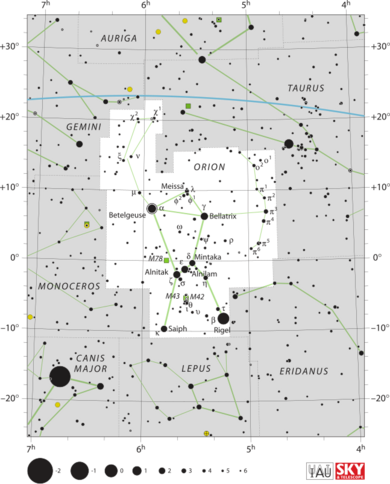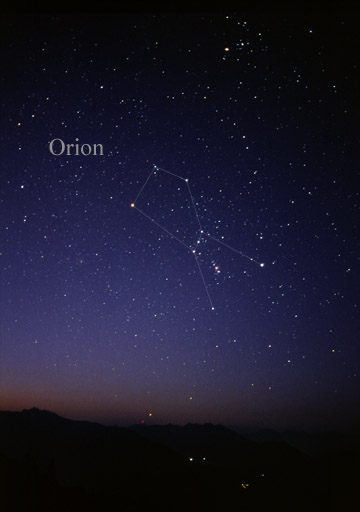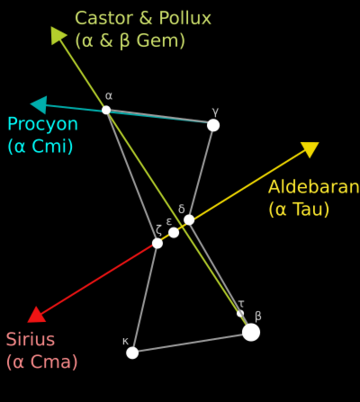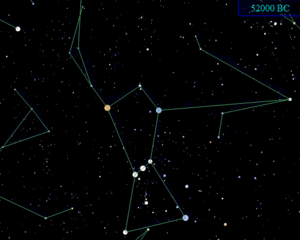Orion (constellation) facts for kids
| Constellation | |

List of stars in Orion
|
|
| Abbreviation | Ori |
|---|---|
| Genitive | Orionis |
| Symbolism | Orion, the Hunter |
| Right ascension | 5h |
| Declination | +5° |
| Quadrant | NQ1 |
| Area | 594 sq. deg. (26th) |
| Main stars | 7 |
| Bayer/Flamsteed stars |
81 |
| Stars with planets | 10 |
| Stars brighter than 3.00m | 8 |
| Stars within 10.00 pc (32.62 ly) | 8 |
| Brightest star | Rigel (β Ori) (0.12m) |
| Messier objects | 3 |
| Meteor showers | Orionids Chi Orionids |
| Bordering constellations |
Gemini Taurus Eridanus Lepus Monoceros |
| Visible at latitudes between +85° and −75°. Best visible at 21:00 (9 p.m.) during the month of January. |
|
Orion is a famous group of stars you can see in the night sky, especially during winter in the Northern Hemisphere. It's one of the 88 constellations we recognize today. People have known about Orion for a very long time; it was even listed by an astronomer named Ptolemy way back in the 2nd century.
Orion is named after a mighty hunter from ancient Greek stories. It's easiest to spot on winter evenings in the Northern Hemisphere. Orion has two super bright stars, Rigel and Betelgeuse, which are among the brightest in the entire night sky! Both of these stars are huge, called supergiants, and their brightness can change a little bit.
You'll also find six other stars in Orion that are brighter than average. Three of these form a short, straight line known as Orion's Belt. Orion is also home to the Orionids, a yearly meteor shower linked to Halley's Comet, and the amazing Orion Nebula, one of the brightest clouds of gas and dust in space.
Contents
What Makes Orion Special?
Orion is surrounded by other constellations. To its northwest is Taurus, to the southwest is Eridanus, and to the south is Lepus. To the east, you'll find Monoceros, and to the northeast, Gemini.
Orion covers a large area of the sky, making it the twenty-sixth largest constellation. Its official borders were set by astronomer Eugène Joseph Delporte in 1930. The International Astronomical Union uses "Ori" as its short name.
You can see Orion best in the evening sky from January to April. This is winter in the Northern Hemisphere and summer in the Southern Hemisphere. If you live near the equator, Orion will appear directly overhead in December around midnight.
Using Orion to Find Other Stars
Orion is super helpful for finding other bright stars in the night sky.
- If you follow the line of Orion's Belt southeast, you'll find Sirius, the brightest star in the sky.
- If you follow the Belt northwest, you'll reach Aldebaran.
- A line drawn across Orion's two shoulders points towards Procyon.
- A line from Rigel through Betelgeuse leads to Castor and Pollux.
- Rigel is also part of a larger star pattern called the Winter Hexagon.
Main Features of Orion
Orion's seven brightest stars create a distinct hourglass shape. Four stars – Rigel, Betelgeuse, Bellatrix, and Saiph – form a large rectangle. In the middle of this rectangle are the three stars of Orion's Belt: Alnitak, Alnilam, and Mintaka.
Above the belt, an eighth star called Meissa marks Orion's head. Hanging down from the "belt" is a smaller line of three "stars" known as Orion's Sword. The middle part of the sword isn't actually a star, but the amazing Orion Nebula.
Many of Orion's stars are very hot, bright blue supergiants. The stars in the belt and sword are part of a group called the Orion OB1 association. Betelgeuse stands out with its reddish color.
Brightest Stars in Orion
- Betelgeuse (Alpha Orionis) is a huge red supergiant star that is nearing the end of its life. It's the second brightest star in Orion and can change its brightness a bit. It forms the hunter's "right shoulder." Betelgeuse is usually one of the top brightest stars in the night sky. Scientists expect it to explode as a supernova sometime in the next 100,000 years. When it does, it will be so bright you might see it during the day!
- Rigel (Beta Orionis) is a blue supergiant star and the seventh brightest star in the night sky. Like Betelgeuse, Rigel is burning heavy elements in its core. It will also eventually become a supernova or a white dwarf. Rigel marks the hunter's left foot.
- Bellatrix (Gamma Orionis) is the twenty-seventh brightest star in the night sky. It's a blue giant star, but not big enough to explode as a supernova. Bellatrix gets its brightness from being very hot. It marks Orion's left shoulder and its name means "female warrior." It's the closest major star in Orion, about 244.6 light years away.
- Mintaka (Delta Orionis) is the faintest of the three stars in Orion's Belt. Its name means "the belt." Mintaka is actually a multiple star system with several stars orbiting each other. The main stars are a blue giant and a more massive O-type star. Mintaka is the westernmost and northernmost star in Orion's Belt.
- Alnilam (Epsilon Orionis) means "string of pearls" in Arabic. It's the middle and brightest star in Orion's Belt. Alnilam is a blue supergiant. Even though it's almost twice as far away as the other belt stars, it's so bright that it looks just as bright from Earth. Alnilam is losing a lot of its mass because of its huge size. It's the farthest major star in Orion, about 1,344 light years away.
- Alnitak (Zeta Orionis) means "the girdle" and is the easternmost star in Orion's Belt. It's a triple star system, meaning it has three stars. The main star is a very hot blue supergiant and the brightest O-class star in the night sky.
- Saiph (Kappa Orionis) marks Orion's right foot. It's similar in distance and size to Rigel but appears much fainter. Its name means "sword of the giant."
- Meissa (Lambda Orionis) forms Orion's head. It's also a multiple star system and its name means "the shining one."
| Proper name |
Bayer designation | Light years | Apparent magnitude |
|---|---|---|---|
| Betelgeuse | α Orionis | 548 | 0.50 |
| Rigel | β Orionis | 863 | 0.13 |
| Bellatrix | γ Orionis | 250 | 1.64 |
| Mintaka | δ Orionis | 1,200 | 2.23 |
| Alnilam | ε Orionis | 1,344 | 1.69 |
| Alnitak | ζ Orionis | 1,260 | 1.77 |
| Saiph | κ Orionis | 650 | 2.09 |
| Meissa | λ Orionis | 1,320 | 3.33 |
Orion's Belt: A Famous Star Pattern
Orion's Belt is a very well-known star pattern within the Orion constellation. It's made up of three bright stars: Alnitak, Alnilam, and Mintaka.
- Alnitak is about 800 light years from Earth. It's 100,000 times brighter than our Sun.
- Alnilam is about 2,000 light years away and is 375,000 times brighter than the Sun.
- Mintaka is 915 light years away and is 90,000 times brighter than the Sun. It's also a double star, with two stars orbiting each other.
In the Northern Hemisphere, Orion's Belt is easiest to see in January around 9:00 pm.
Orion's Sword: Home to Nebulae
Orion's Sword hangs from the belt. It contains the famous Orion Nebula, the Messier 43 nebula, and the Running Man Nebula. It also includes the stars Theta Orionis, Iota Orionis, and 42 Orionis.
Orion's Head, Club, and Shield
- Head: Three stars form a small triangle for Orion's head. The top star is Meissa.
- Club: Stretching north from Betelgeuse are the stars that make up Orion's club.
- Shield: West of Bellatrix are six stars that form Orion's shield.
Orionid Meteor Shower
Around October 20 each year, the Orionid meteor shower reaches its peak. You can see up to 20 meteors per hour! These meteors come from dust left behind by Halley's Comet.
Amazing Deep-Sky Objects

Hanging from Orion's belt is his sword, which includes the Orion Nebula (M42). This is an amazing object that you can see with your bare eyes as a fuzzy patch, not just a star. If you use binoculars, you can see its clouds of new stars, glowing gas, and dust. The Orion Nebula is a place where many new stars are being born.
M78 (NGC 2068) is another nebula in Orion. It's dimmer than the Great Orion Nebula but is about the same distance from Earth. Another bright nebula is NGC 1999, also near the Great Orion Nebula.
Another famous nebula is IC 434, known as the Horsehead Nebula. It has a dark cloud of dust shaped like a horse's head.
All these nebulae are part of a much larger area called the Orion molecular cloud complex. This huge cloud is about 1,500 light-years away and is one of the most active places in our galaxy where new stars are forming.
Orion in History and Mythology
The unique pattern of Orion has been recognized by many cultures around the world, and many myths are linked to it.
Ancient Stories
- Babylon: In ancient Babylon, Orion was called The Heavenly Shepherd.
- Egypt: Ancient Egyptians saw Orion as a god named Sah. He was linked to Osiris, a very important god.
- Armenia: The Armenians connected Orion with their legendary founder, Hayk.
- Bible: The Bible mentions Orion three times, calling it "Kesil."
- Greece and Rome: In Greek mythology, Orion was a giant, super-strong hunter. One story says that the goddess Gaia sent a scorpion to kill Orion because he boasted he would kill every animal. This is why the constellations of Scorpius and Orion are never seen in the sky at the same time.
Around the World
- Middle East: In medieval Muslim astronomy, Orion was known as al-jabbar, "the giant."
- China: In China, Orion was called Shen, meaning "three," referring to the three stars of Orion's Belt.
- India: The Rigveda calls Orion Mriga (The Deer). Some also see the cosmic dancer Nataraja as a symbol of Orion.
- Hungary: In old Hungarian stories, Orion is known as "Archer" or "Reaper." He is sometimes called Nimrod, a great hunter.
- Scandinavia: Orion's belt was known as "Frigg's Distaff" or "Freyja's distaff."
- Finland: The Finns call Orion's belt and the stars below it "Väinämöinen's scythe" or "Väinämöinen's Belt."
- Americas: The Seri people in Mexico call the belt stars Hapj (a hunter). In Latin America, the three belt stars are often called "Las tres Marías" (The Three Marys) or "Los Tres Reyes Magos" (The Three Wise Men). The Ojibwa Native Americans call it Kabibona'kan, the Winter Maker. The Lakota see Orion's Belt as the spine of a bison.
- Austronesia: In Māori tradition, the star Rigel is important for the Matariki celebration, marking the start of the Māori year. In Javanese culture, Orion is called Lintang Waluku or Bintang Bajak, like a plow.
Modern Symbols
The image of Orion's belt and sword has appeared in modern culture. For example, the 27th Infantry Division of the United States Army used it as their shoulder symbol. The film company Orion Pictures also uses the constellation as its logo.
What the Future Holds for Orion
Orion is currently located near the celestial equator, an imaginary line in the sky. However, because of how Earth's axis slowly wobbles (called precession), Orion will slowly move southward in the sky. By the year 14000 AD, Orion will be so far south that people in places like Great Britain won't be able to see it anymore.
Even further in the future, the stars that make up Orion will slowly move apart due to their own motion through space. But because Orion's brightest stars are very far away from Earth, the constellation will still look recognizable for a long time. Some of its stars, like Betelgeuse, are expected to explode as supernovae within the next million years, which will be an amazing sight!
See also
 In Spanish: Orión (constelación) para niños
In Spanish: Orión (constelación) para niños
- EURion constellation
- Hubble 3D (2010), IMAX film with an elaborate CGI "fly-through" of the Orion Nebula
- Orion correlation theory
- Orion (mythology)
- Orion (Chinese astronomy)
- Aurvandill
- Glooscap
- Heiheionakeiki
- Julpan
- Nataraja
- Osiris
- Papsukkal
- Urania
- Winter Hexagon







